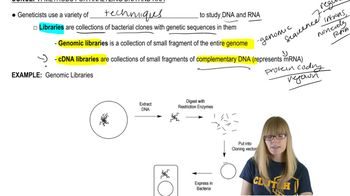Table of contents
- 1. Introduction to Genetics51m
- 2. Mendel's Laws of Inheritance3h 37m
- 3. Extensions to Mendelian Inheritance2h 41m
- 4. Genetic Mapping and Linkage2h 28m
- 5. Genetics of Bacteria and Viruses1h 21m
- 6. Chromosomal Variation1h 48m
- 7. DNA and Chromosome Structure56m
- 8. DNA Replication1h 10m
- 9. Mitosis and Meiosis1h 34m
- 10. Transcription1h 0m
- 11. Translation58m
- 12. Gene Regulation in Prokaryotes1h 19m
- 13. Gene Regulation in Eukaryotes44m
- 14. Genetic Control of Development44m
- 15. Genomes and Genomics1h 50m
- 16. Transposable Elements47m
- 17. Mutation, Repair, and Recombination1h 6m
- 18. Molecular Genetic Tools19m
- 19. Cancer Genetics29m
- 20. Quantitative Genetics1h 26m
- 21. Population Genetics50m
- 22. Evolutionary Genetics29m
18. Molecular Genetic Tools
Methods for Analyzing DNA
Problem 27a
Textbook Question
Genomic DNA from the nematode worm Caenorhabditis elegans is organized by nucleosomes in the manner typical of eukaryotic genomes, with 145 bp encircling each nucleosome and approximately 55 bp in linker DNA. When C. elegans chromatin is carefully isolated, stripped of nonhistone proteins, and placed in an appropriate buffer, the chromatin decondenses to the 10-nm fiber structure. Suppose researchers mix a sample of 10-nm–fiber chromatin with a large amount of the enzyme DNase I that randomly cleaves DNA in regions not protected by bound protein. Next, they remove the nucleosomes, separate the DNA fragments by gel electrophoresis, and stain all the DNA fragments in the gel. How do the expected results support the 10-nm–fiber model of chromatin?
 Verified step by step guidance
Verified step by step guidance1
Understand the structure of chromatin: In eukaryotic cells, DNA is wrapped around histone proteins to form nucleosomes, which are the basic units of chromatin. Each nucleosome consists of approximately 145 base pairs (bp) of DNA wrapped around a histone octamer, with linker DNA of about 55 bp connecting adjacent nucleosomes.
Recognize the role of DNase I: DNase I is an enzyme that cleaves DNA at random sites, but it cannot cut DNA that is tightly bound to proteins, such as the DNA wrapped around histones in nucleosomes. Therefore, DNase I will preferentially cut the linker DNA between nucleosomes.
Predict the pattern of DNA fragments: When the chromatin is treated with DNase I, the enzyme will cleave the linker DNA, resulting in DNA fragments that correspond to the length of DNA protected by nucleosomes. This means you would expect to see DNA fragments of approximately 145 bp, which is the length of DNA wrapped around each nucleosome.
Analyze the gel electrophoresis results: After DNase I treatment, the DNA fragments are separated by size using gel electrophoresis. If the 10-nm fiber model is correct, the gel should show a prominent band at around 145 bp, indicating the presence of nucleosome-protected DNA fragments.
Interpret the results in the context of chromatin structure: The presence of a distinct band at 145 bp supports the 10-nm fiber model of chromatin, as it demonstrates that the DNA is organized into nucleosomes with linker DNA that is susceptible to DNase I cleavage. This pattern confirms the regular spacing and protection of DNA by nucleosomes in the chromatin structure.
Recommended similar problem, with video answer:
 Verified Solution
Verified SolutionThis video solution was recommended by our tutors as helpful for the problem above
Video duration:
3mPlay a video:
Was this helpful?
Key Concepts
Here are the essential concepts you must grasp in order to answer the question correctly.
Nucleosome Structure
Nucleosomes are the fundamental units of chromatin, consisting of a segment of DNA wrapped around a core of histone proteins. Each nucleosome typically contains about 145 base pairs of DNA, which helps package the DNA into a compact structure. This organization is crucial for regulating gene expression and DNA accessibility, as the positioning of nucleosomes can either expose or shield DNA sequences from transcription factors and other regulatory proteins.
Recommended video:
Guided course

Chromosome Structure
10-nm Fiber Model
The 10-nm fiber, also known as 'beads on a string,' represents the initial level of chromatin organization where nucleosomes are spaced along the DNA strand. This structure is essential for understanding how DNA is compacted within the nucleus while still allowing for some accessibility for transcription and replication. The presence of linker DNA between nucleosomes contributes to this fiber's flexibility and dynamic nature, which is important for chromatin remodeling.
Recommended video:
Guided course

Chromosome Structure
DNase I Sensitivity
DNase I is an enzyme that cleaves DNA at sites that are not protected by bound proteins, such as histones in nucleosomes. When chromatin is treated with DNase I, the resulting DNA fragments can indicate the accessibility of the chromatin structure. If the 10-nm fiber model is accurate, we would expect to see specific patterns of DNA cleavage that reflect the positions of nucleosomes and linker DNA, supporting the idea that the chromatin is organized in a way that allows for both protection and accessibility.
Recommended video:
Guided course

Lac Operon Regulation

 7:40m
7:40mWatch next
Master Methods for Analyzing DNA and RNA with a bite sized video explanation from Kylia Goodner
Start learningRelated Videos
Related Practice


